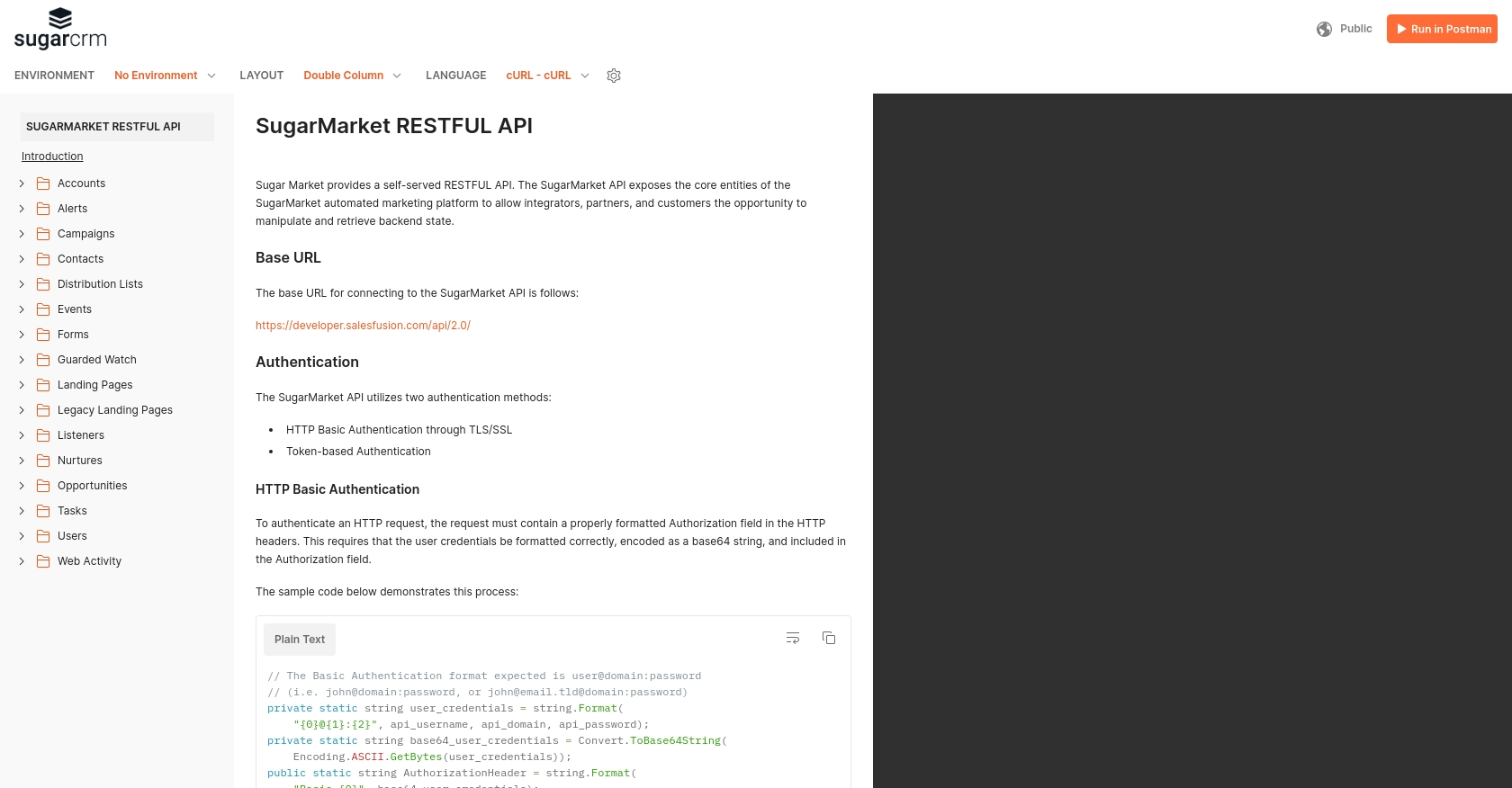Using the Sugar Market API to Get Opportunities (with Python examples)

Introduction to Sugar Market API
Sugar Market, part of the SugarCRM suite, is a powerful marketing automation platform designed to enhance marketing efforts through advanced analytics, campaign management, and lead nurturing. It offers a comprehensive set of tools that help businesses streamline their marketing processes and drive growth.
Developers may want to integrate with the Sugar Market API to access and manage marketing data, such as opportunities, to optimize sales strategies and improve customer engagement. For example, a developer could use the Sugar Market API to retrieve opportunity data and analyze it to identify potential sales trends and opportunities for upselling.
Setting Up Your Sugar Market Test/Sandbox Account
Before you can start interacting with the Sugar Market API, you'll need to set up a test or sandbox account. This environment allows you to safely experiment with API calls without affecting live data.
Creating a Sugar Market Sandbox Account
If you don't already have a Sugar Market account, you can sign up for a free trial or request access to a sandbox environment through the Sugar Market website. This will provide you with the necessary credentials to begin testing.
Generating API Credentials for Sugar Market
Once your sandbox account is set up, you'll need to generate API credentials to authenticate your requests. Sugar Market uses a custom authentication method, so follow these steps to obtain your credentials:
- Log in to your Sugar Market sandbox account.
- Navigate to the API settings section, typically found under the developer or integrations tab.
- Follow the instructions to create a new API application. This process will provide you with a client ID and client secret.
- Ensure you have the necessary permissions to access opportunity data by selecting the appropriate scopes during the app creation process.
- Save your client ID and client secret securely, as you'll need them to authenticate your API requests.
For more detailed information on setting up your API credentials, refer to the Sugar Market API documentation.

sbb-itb-96038d7
Making API Calls to Retrieve Opportunities from Sugar Market Using Python
To interact with the Sugar Market API and retrieve opportunity data, you'll need to use Python, a versatile programming language known for its simplicity and readability. This section will guide you through the process of setting up your environment and making API calls to access opportunities in Sugar Market.
Setting Up Your Python Environment for Sugar Market API Integration
Before making API calls, ensure you have Python installed on your machine. This tutorial uses Python 3.11.1. Additionally, you'll need the requests library to handle HTTP requests.
- Install Python 3.11.1 from the official Python website if you haven't already.
- Use pip to install the
requestslibrary by running the following command in your terminal:
pip install requestsExample Code to Retrieve Opportunities from Sugar Market
With your environment set up, you can now write a Python script to make an API call to Sugar Market and retrieve opportunity data. Replace Your_Client_ID and Your_Client_Secret with the credentials you obtained earlier.
import requests
# Define the API endpoint and headers
endpoint = "https://api.sugarmarket.com/opportunities"
headers = {
"Content-Type": "application/json",
"Authorization": "Bearer Your_Client_ID:Your_Client_Secret"
}
# Make a GET request to the API
response = requests.get(endpoint, headers=headers)
# Check if the request was successful
if response.status_code == 200:
opportunities = response.json()
for opportunity in opportunities:
print(opportunity)
else:
print(f"Failed to retrieve opportunities. Status code: {response.status_code}")
This script sends a GET request to the Sugar Market API to fetch opportunities. If successful, it prints the opportunity data. Otherwise, it displays an error message with the status code.
Verifying API Call Success and Handling Errors
After running the script, verify the success of your API call by checking the output in your terminal. The retrieved opportunities should match those in your Sugar Market sandbox account.
To handle errors effectively, consider implementing additional error handling based on the API's documentation. This might include checking for specific error codes and retrying requests if necessary.
For more information on error codes and handling, refer to the Sugar Market API documentation.
Conclusion and Best Practices for Using Sugar Market API
Integrating with the Sugar Market API allows developers to efficiently access and manage marketing data, enhancing sales strategies and customer engagement. By following the steps outlined in this guide, you can successfully retrieve opportunity data using Python, enabling data-driven decision-making.
Best Practices for Secure and Efficient API Integration
- Securely Store Credentials: Always store your client ID and client secret securely. Consider using environment variables or a secure vault to protect sensitive information.
- Handle Rate Limiting: Be aware of any rate limits imposed by the Sugar Market API. Implement retry logic with exponential backoff to handle rate limit errors gracefully.
- Standardize Data Fields: Transform and standardize data fields to ensure consistency across different systems and applications.
- Error Handling: Implement robust error handling by checking for specific error codes and providing meaningful feedback to users or logs.
Streamline Your Integrations with Endgrate
While integrating with individual APIs like Sugar Market can be rewarding, it can also be time-consuming and complex, especially when managing multiple integrations. Endgrate simplifies this process by providing a unified API endpoint that connects to various platforms, including Sugar Market.
By using Endgrate, you can save time and resources, allowing you to focus on your core product. Build once for each use case and enjoy an intuitive integration experience for your customers. Explore how Endgrate can enhance your integration strategy by visiting Endgrate.
Read More
Ready to get started?

